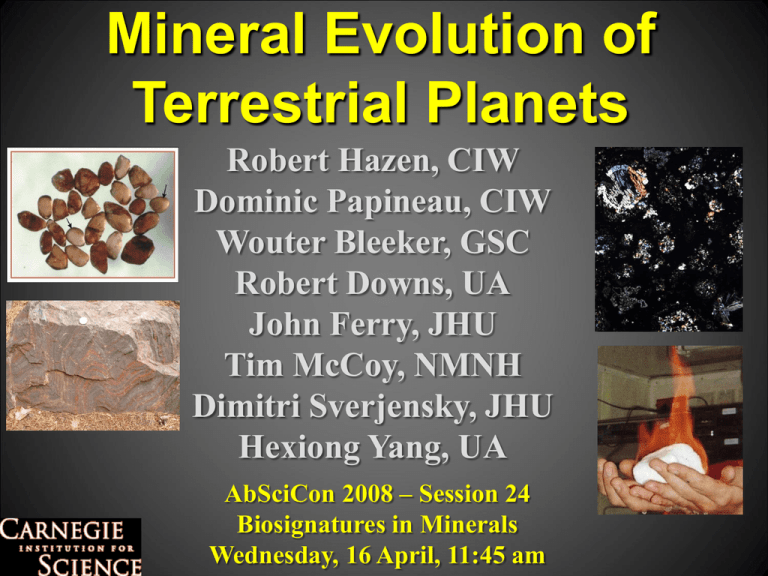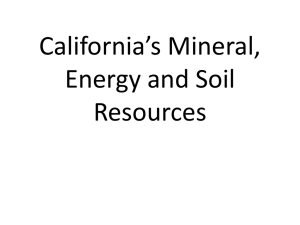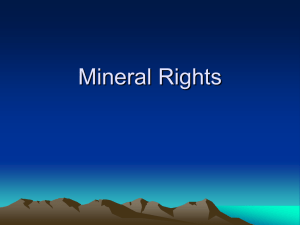PPT - Robert Hazen
advertisement

Mineral Evolution of Terrestrial Planets Robert Hazen, CIW Dominic Papineau, CIW Wouter Bleeker, GSC Robert Downs, UA John Ferry, JHU Tim McCoy, NMNH Dimitri Sverjensky, JHU Hexiong Yang, UA AbSciCon 2008 – Session 24 Biosignatures in Minerals Wednesday, 16 April, 11:45 am What Is Mineral Evolution? A change over time in: • The diversity of mineral species • The relative abundances of minerals • The compositional ranges of minerals • The grain sizes and morphologies of minerals “Ur”-Mineralogy Pre-solar grains contain about a dozen microand nano-mineral phases: • • • • • • • • • • • • Diamond/Lonsdaleite Graphite Moissanite (SiC) Osbornite (TiN) Nierite (Si3N4) Rutile Corundum Spinel Hibbonite (CaAl12O19) Forsterite Nano-particles of TiC, ZrC, MoC, FeC, Fe-Ni metal within graphite. GEMS (silicate glass with embedded metal and sulfide). How did we get from a dozen minerals to >4300 on Earth today? (Focus on near-surface) What Drives Mineral Evolution? Deterministic and stochastic processes that occur on any terrestrial body: 1. The progressive separation and concentration of chemical elements from their original uniform distribution. 2. An increase in the range of intensive variables (T, P, activities of volatiles). 3. The generation of far-from-equilibrium conditions by living systems. Three Eras of Earth’s Mineral Evolution 1. The Era of Planetary Accretion 2. The Era of Crust and Mantle Reworking 3. The Era of Bio-Mediated Mineralogy Stage 1: Primary Chondrite Minerals Minerals formed ~4.56 Ga in the Solar nebula “as a consequence of condensation, melt solidification or solid-state recrystallization” (MacPherson 2007) ~60 mineral species: • CAIs • Chondrules • Silicate matrix • Opaque phases Stage 2: Aqueous alteration, metamorphism and differentiation of planetesimals ~250 mineral known species: 4.56-4.55 Ga • • • • • • • First albite & K-spar First significant SiO2 Feldspathoids Hydrous biopyriboles Clay minerals Zircon Shock phases Stage 3: Initiation of Igneous Rock Evolution (4.55-4.0 Ga) Norman Bowen Partial melting, fractional crystallization and magma immiscibility Stage 3: Initiation of Igneous Rock Evolution Volatile-poor Body ~350 mineral species? Is this the end point of the Moon and Mercury? Stage 3: Initiation of Igneous Rock Evolution Volatile-rich Body (4.55-4.0 Ga) >500 mineral species (hydroxides, clays) Volcanism, outgasing and surface hydration. The Formation of the Moon Stage 3: Initiation of Igneous Rock Evolution Volatile-rich Body >500 mineral species (hydroxides, clays) Volcanism, outgasing and surface hydration. Stage 3: Initiation of Igneous Rock Evolution Volatile-rich Body Is this as far as Mars or Venus progressed? Volcanism, outgasing and surface hydration. Stage 4: Granitoid Formation (>3.5 Ga) >1000 mineral species (pegmatites) Partial melting of basalt and/or sediments. Stage 4: Granitoid Formation (>3.5 Ga) >1000 mineral species (pegmatites) Complex pegmatites require multiple cycles of eutectic melting and fluid concentration (i.e., younger than 3.5 Ga?). Stage 4: Granitoid Formation Are there pegmatites on Mars? Are there emeralds on Venus? Stage 5: Plate tectonics and large-scale hydrothermal reworking of the crust (>3 Ga) 1,500 mineral species (sulfides, sulphosalts) Massive base metal deposits; exposure of high-P metamorphic terrains; new hydrated minerals. Stage 5: Plate tectonics and large-scale hydrothermal reworking of the crust (>3 Ga) Does the origin of life require some minimal degree of mineral evolution? Stage 6: Anoxic Archean biosphere (3.9-2.5 Ga) ~1,500 mineral species (BIFs, carbonates, sulfates, evaporites, skarns) Temagami BIFs, ~2.7 Ga Photo credit: D. Papineau Stage 7: Paleoproterozoic Oxidation (2.5-1.9 Ga) >4000 mineral species, including perhaps 2,000 new oxides/hydroxides Negaunee BIF, ~1.9 Ga Rise of oxidative photosynthesis. Stage 7: Paleoproterozoic Oxidation (2.5-1.9 Ga) >4000 mineral species (oxy-hydroxides) 202 of 220 U minerals 319 of 451 Mn minerals Piedmontite 47 of 56 Ni minerals 582 of 790 Fe minerals Garnierite Xanthoxenite Stage 7: Paleoproterozoic Oxidation (2.5-1.9 Ga) Especially copper minerals! Stage 8: The “Intermediate Ocean” (1.9-1.0 Ga) >4000 mineral species (few new species) Oxidized surface ocean; deep-ocean anoxia. Stage 9: Snowball Earth and Neoproterozoic Oxidation (1.0-0.542 Ga) >4000 mineral species (few new species) Skeleton Coast, Namibia Glacial cycles triggered by albedo feedback. Stage 10: Phanerozoic Biomineralization (<0.542 Ga) >4,300 mineral species Implications of Mineral Evolution • Defines a way to categorize terrestrial planets and moons. • Implies mission targets: mineral biosignatures (and abiosignatures). • Provides insights on the evolution of complex systems. •Represents a new way to frame (and to teach) mineralogy. Conclusions • The mineralogy of terrestrial planets and moons evolves in both deterministic and stochastic ways. • Three principal mechanisms of change: 1. Element segregation & concentration 2. Increasing ranges of T, P and X 3. Influence of living systems. • Different bodies achieve different stages of mineral evolution.









